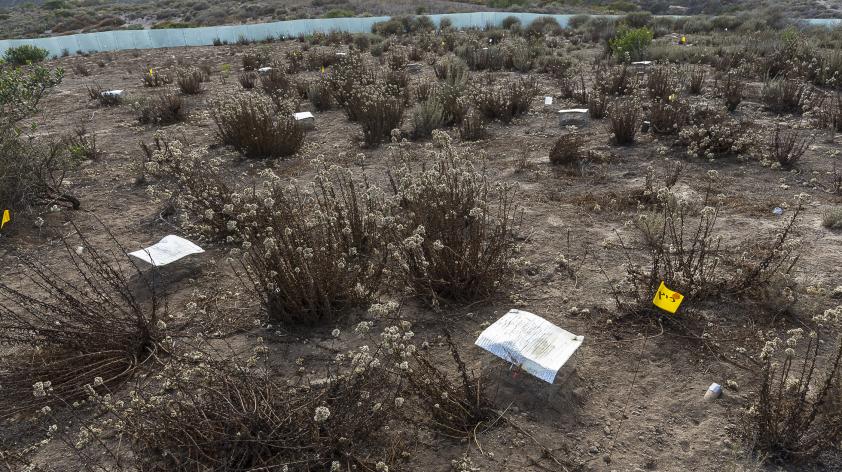
One Month Post-release Check-up
It has been a nerve wracking month since we released 50 Pacific pocket mice (PPM) into the wild at Laguna Coast Wilderness Park. Each day I wonder how the mice are adjusting to their new environment and a million questions fill my mind. Are they foraging? Are they making new burrows? Are they continuing to use their acclimation cages? How have they behaved upon encountering predators and competitors? During the past few weeks we have used two sampling techniques – trail cameras, and trapping – to help provided some answers, and as a side benefit, calm the nerves.
Trail Cameras
We placed 20 trail cameras around the reintroduction site at acclimation cages, supplemental feeding stations, or burrows, and changed the location of the cameras every 1-2 weeks. The cameras have a motion and heat sensor that takes a picture and a video when it senses a change in infrared light. This occurs when an animal, person, and/or vegetation moves in the frame.
The images captured so far have been reassuring. We are seeing the PPM exhibit natural behaviours such as foraging, grooming, and digging, and using the supplemental feeding stations (Photo 1). We have also seen the mice continue to use the acclimation cages. These are the cages that we temporarily held them at the release site to give them time to adjust to their new home. Since we left the biodegradable below ground portion of the acclimation cages in place, the mice are able to use them for shelter and to build up seed reserves. Another highlight of the footage is what we are not seeing: no predation events have been captured yet!
In addition to predation, one of our main concerns for the PPM is whether or not they are being displaced by the larger, more dominant small mammal species in the community (i.e. cactus mouse, California pocket mouse, deer mouse, and Dulzura kangaroo rat). To date, very few images or videos of heterospecific interactions have been observed. A possible explanation is that the PPM may be shifting their active times to when the heterospecific species are less active. Or, they may avoid interactions by moving to a different part of the release site. A more thorough review of the photos and videos will help us learn about what is happening during this initial period of establishment.
Trapping
To assess overall health, and survivorship of the PPM, as well as to estimate competitor densities, we trapped at the reintroduction site one-month post-release. We checked more than 2100 traps over six nights. The traps were opened and baited at dusk, and checked twice each night (i.e. 2330 and 0330). I’ll never forget how I felt when I walked the trap lines, and found my first closed trap. Butterflies filled my stomach…who would it be? It was a docile cactus mouse, #322 (in a prior trapping effort, we had ear tagged the competitors, except for the California pocket mice because their ears are too small). The next closed trap was an energetic California pocket mouse. I was now on my second line of traps, and started to worry about the fate of the PPM released. When I got to the third closed trap, it felt light. I was hopeful that it could be one of our PPM, but nervous that it might be empty. I lowered the trap door slightly, and peering up at me was a tiny PPM!
I got the mouse into a clear plastic bag, and ran through our usual processing procedure: I weighed it, and determined the sex and reproductive status. I then scanned the tail with a laser to identify the mouse… it was #92! #92 was from the first litter born in 2015. She had been a very active, and feisty female in the facility, and I was not surprised that she would be a mouse that we would catch. I was thrilled to see that she was in good health: her coat was shiny, she was energetic, and she was a great weight, 6.75 g (adult PPM weigh between 6.0 and 7.0 g). I released her, and watched her scurry for cover, a behaviour that I was also happy to see as it makes PPM difficult for predators to find. Over the remaining trap checks, I saw #92 multiple times. She is a mouse that we refer to as “trap happy.”
During the trapping effort, we caught 24 PPM (48%). This is the minimum number known to be alive. Just as there are “trap happy” animals, there are “trap shy” animals that we will likely never catch, but remain alive at the release site.
Another encouraging piece of information obtained from the trapping was that the mice were reproductive -- females were cycling, and males were scrotal. In order for a reintroduction to be successful, the mice have to survive, and reproduce. We will be conducting one last round of trapping in September (three-months post-release) before the mice are mostly inactive for the winter. My hope is that we will catch juvenile PPM as this would mean the mice are becoming established in their new home.
It is extremely gratifying to see the mice returned to the wild, and exploring and settling into their natural environment. Reintroductions are tough and a lot of work, but necessary to save some species from the brink of extinction.













